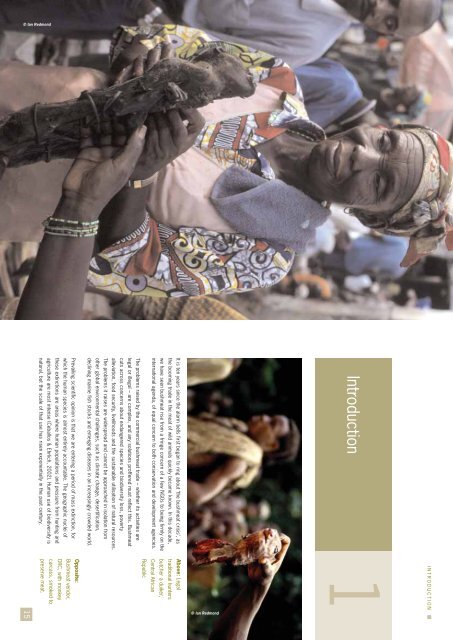- Page 1 and 2: Recipes for Survival:Controlling th
- Page 3 and 4: 3.4. The effects of bushmeat huntin
- Page 5 and 6: 8RECIPES FOR SURVIVALExecutive Summ
- Page 7: WSPA/APE ALLIANCE12RECIPES FOR SURV
- Page 11 and 12: THE BROADER BUSHMEAT ISSUEThe broad
- Page 13 and 14: WSPA/APE ALLIANCERECIPES FOR SURVIV
- Page 15 and 16: WSPA/APE ALLIANCERECIPES FOR SURVIV
- Page 17 and 18: WSPA/APE ALLIANCERECIPES FOR SURVIV
- Page 19 and 20: WSPA/APE ALLIANCERECIPES FOR SURVIV
- Page 21 and 22: WSPA/APE ALLIANCERECIPES FOR SURVIV
- Page 23 and 24: Primate bushmeat:current situation4
- Page 25 and 26: RECIPES FOR SURVIVALPRIMATE BUSHMEA
- Page 27 and 28: WSPA/APE ALLIANCERECIPES FOR SURVIV
- Page 29 and 30: WSPA/APE ALLIANCERECIPES FOR SURVIV
- Page 31 and 32: Actions ongoing andtheir effectiven
- Page 33 and 34: WSPA/APE ALLIANCERECIPES FOR SURVIV
- Page 35 and 36: WSPA/APE ALLIANCERECIPES FOR SURVIV
- Page 37 and 38: WSPA/APE ALLIANCERECIPES FOR SURVIV
- Page 39 and 40: OBSTACLES TO CHANGEObstacles to cha
- Page 41 and 42: POTENTIAL SOLUTIONSPotential soluti
- Page 43 and 44: WSPA/APE ALLIANCERECIPES FOR SURVIV
- Page 45 and 46: RECIPES FOR SURVIVALSupport for cer
- Page 47 and 48: WSPA/APE ALLIANCERECIPES FOR SURVIV
- Page 49 and 50: WSPA/APE ALLIANCERECIPES FOR SURVIV
- Page 51 and 52: RECIPES FOR SURVIVALto hunters and
- Page 53 and 54: RECIPES FOR SURVIVALAPPENDIXWSPA/AP
- Page 55 and 56: 108RECIPES FOR SURVIVAL.Organisatio
- Page 57 and 58: Gouala, J. (2005). Forum breathes l
- Page 59 and 60:
Redmond, I. (2001) Coltan Boom, Gor
- Page 61 and 62:
Muntiacus vuquangensis GIANT MUNTJA
- Page 63 and 64:
Pteropus ornatus ORNATE FLYING FOXP
- Page 65 and 66:
Miopithecus talapoin talapoin (W&C)
- Page 67 and 68:
Myosciurus pumilio African pygmy sq
- Page 69 and 70:
Ducula oceanica MICRONESIAN IMPERIA
- Page 71 and 72:
Alectoris chukar Chukar partridgeAl
- Page 73 and 74:
Pelecanus rufescens Pink-backed pel
- Page 75 and 76:
Sacalia quadriocellata Four-eyed tu
- Page 77 and 78:
Rana fukienensisRana grahamiRana gu
- Page 79 and 80:
Rhynchophorus ferrugineus papuanusR
- Page 81 and 82:
Hypoderma bovisOedemagena tarandiRh
- Page 83 and 84:
Ugada giovanninaUgada limbalisUgada
- Page 85 and 86:
PolybiaPolybia diguetanaPolybia ign
- Page 87 and 88:
Anaphe venataAntheua insignataDesme
- Page 89 and 90:
Acrida giganteaAcrida lataAcrida su
- Page 91 and 92:
PhasmatodeaPhasmatidaeEurycantha ho
- Page 93 and 94:
DD South and South and SE AsiaLR/lc
- Page 95 and 96:
VU A2c OceaniaVU A2b+3d Sub-Saharan
- Page 97 and 98:
LR/lc Sub-Saharan AfricaLR/lc Sub-S
- Page 99 and 100:
DD Sub-Saharan AfricaLC Sub-Saharan
- Page 101 and 102:
NT OceaniaVU B1ab(ii,iii,iv,v) Sout
- Page 103 and 104:
LC South and SE AsiaLC EuropeVU A2c
- Page 105 and 106:
LC Sub-Saharan AfricaCR D MesoAmeri
- Page 107 and 108:
EN A1d+2d South and SE AsiaVU A1cd+
- Page 109 and 110:
LC South and SE AsiaNT East Asia, S
- Page 111 and 112:
OceaniaMesoAmerica, Carribbean Isla
- Page 113 and 114:
North AmericaNorth AmericaNorth Ame
- Page 115 and 116:
Sub-Saharan AfricaSub-Saharan Afric
- Page 117 and 118:
MesoAmericaMesoAmericaSouth America
- Page 119 and 120:
Sub-Saharan AfricaSub-Saharan Afric
- Page 121 and 122:
West/Central AsiaEast AsiaSub-Sahar
- Page 123 and 124:
OceaniaOceaniaOceaniaSouth and SE A
- Page 125 and 126:
Papio cynocephalus Yellow baboon LR
- Page 127 and 128:
Berggorilla & Regenwald Stuttgart Z
- Page 129 and 130:
Bushmeat Crisis TaskForceJGI Africa
- Page 131 and 132:
COMIFAC (Council ofMinisters for Fo
- Page 133 and 134:
EAZA EAZA, IFAW EAZA Petition again
- Page 135 and 136:
Heifer International South West Far
- Page 137 and 138:
IUCN Conservation Breeding Speciali
- Page 139 and 140:
MINEF Anti-poaching unit CameroonMi
- Page 141 and 142:
Philadelphia Zoo Bushmeat Education
- Page 143 and 144:
TRAFFIC Review of bushmeat trade in
- Page 145 and 146:
WCS WCS Determining economics ofbus
- Page 147 and 148:
WCS, Bronx Zoo WCS Pattycake Fund W
- Page 149 and 150:
Wildlife Conservation Society, Amer
- Page 151 and 152:
WWF ? Vision for Biodiversity in Co
- Page 153 and 154:
Categories Keywords Dates Contact U
- Page 155 and 156:
Surveys, Research,Community Researc
- Page 157 and 158:
Funding, Research1995 - presentFund
- Page 159 and 160:
Livelihoods, Poverty,2002 Joanna El
- Page 161 and 162:
Coltan, MiningInformation , Educati
- Page 163 and 164:
Policy making, Exchangeinfo, Discus
- Page 165 and 166:
Awareness, Timber,Furniture, Coltan
- Page 167 and 168:
Bushmeat, Trade,Methodologies,Educa
- Page 169 and 170:
Self-sufficiency, Foodsecurity,Food
- Page 171 and 172:
Bushmeat, Utilization,Sustainabilit
- Page 173 and 174:
Population, Density,Foods, Research
- Page 175 and 176:
Law enforcement,Hunting, Densities,
- Page 177 and 178:
Campaigning, Primates,Apes, Awarene
- Page 179 and 180:
Research, Modeling,Birds, Fish, Pri
- Page 181 and 182:
Cameroon governmentMINEF Cameroon M
- Page 183 and 184:
Gorilla HavenGov CongoGov. Cameroon
- Page 185 and 186:
Peace CorpsPeopleandPlanet.netPercy
- Page 187 and 188:
Wisconsin Primate Research Center (
- Page 189 and 190:
11111412131116121112121124121916111
- Page 191 and 192:
122111112 Governments of Republic o
- Page 193 and 194:
2114111122 Primate Conservation1311
- Page 195:
286 World Resources Institute (WRI)


